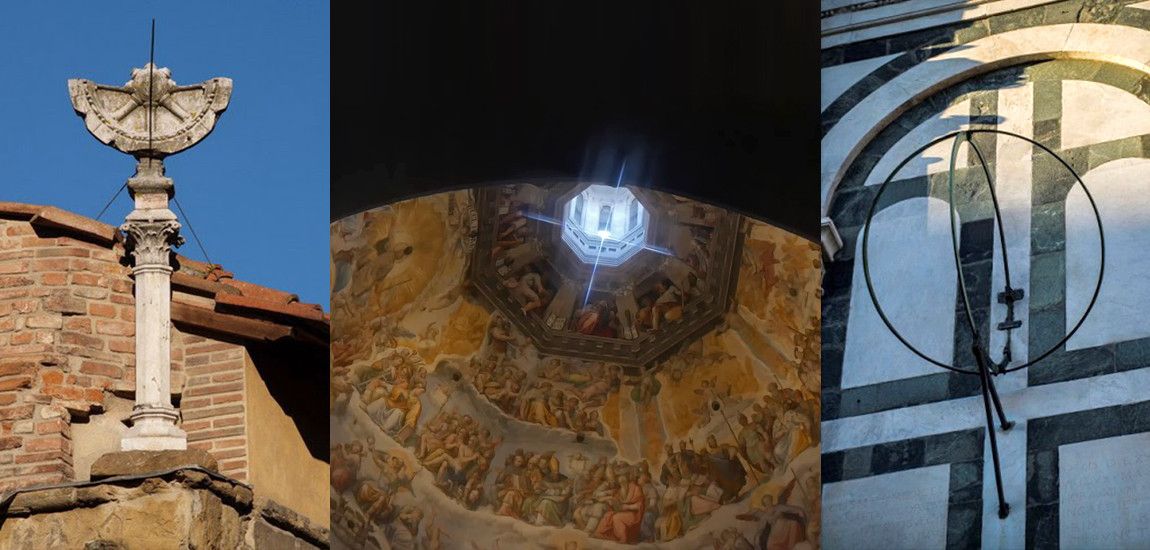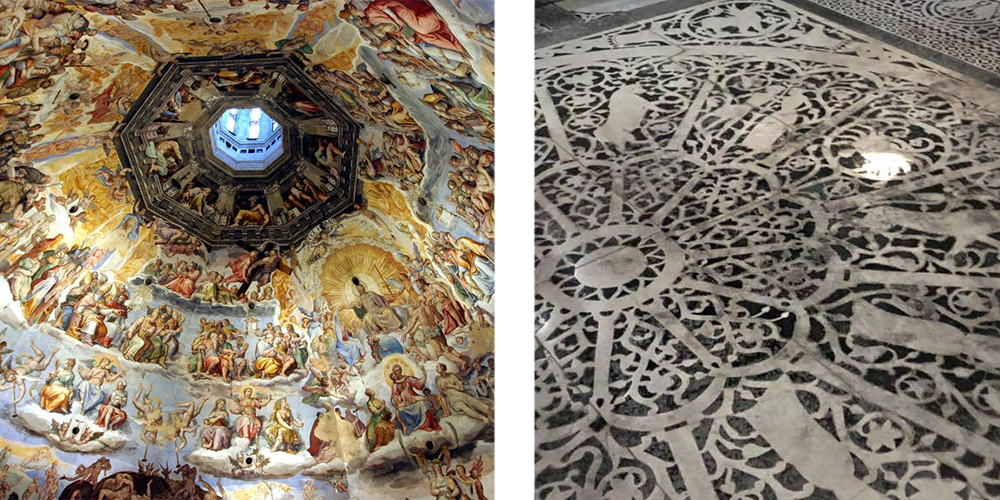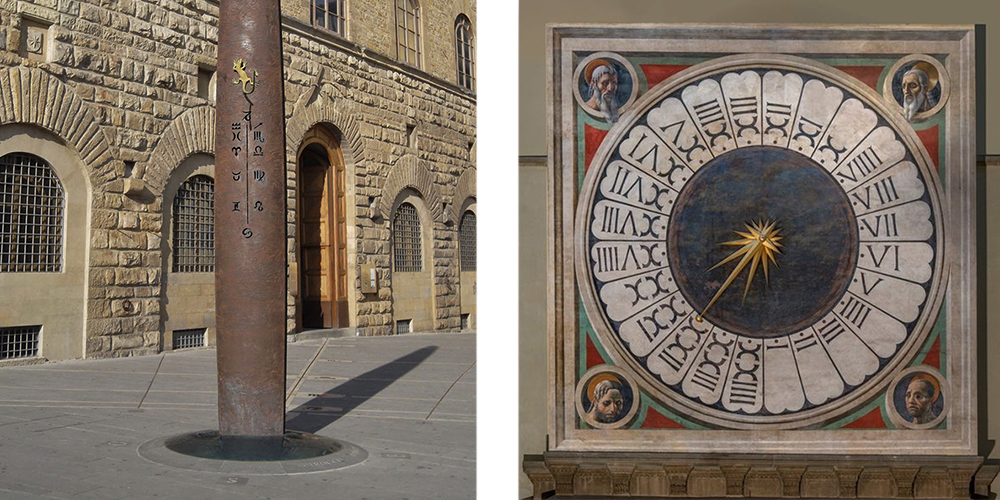
Florence and the instruments that mark the time
A good observer will discover that in Florence there are several astronomical instruments scattered around the city, not only great breeding ground for artists but also for scientists and scholars.
In ancient times, to know the time people used the sundial, a measurement tool based on the detection of the position of the sun. Sundials had a gnomon, the bar whose shadow marked the time on the dial. A different type of gnomon was also used to mark, through a beam of light, the passage of the sun during certain times of the year, signaling soltices and equinoxes.
The gnomon of the Duomo
In Santa Maria del Fiore we can find the kind of sundial that instead of using the shadow as a clock hand, uses light.
A gnomic hole, in fact, is located at the top of Brunelleschi's dome and projects a circle of light on the floor of the cathedral, in correspondence of the Chapel of the Cross, to mark the time of day and period of the year.
The hole, of only 5 cm, was installed by the mathematician Paolo dal Pozzo Toscanelli in 1475 and still today - for a few days a year, near the summer solstice - it is possible to observe the phenomenon of the passage of the sun inside the cathedral, where the sunbeam moves to hit a marble circle that indicates the position where the sun is at the solstice.
Later, in 1755, it was Leonardo Ximenes who added a meridian line set in the floor of the Chapel of the Cross to calculate accurately the inclination of the earth's axis.
In order for this time measuring instrument to be as accurate as possible, a very long distance between the light entry hole and the dial was necessary. For this reason these sundials are often found in cathedrals, the ideal places for such measurements thanks to their imposing height.
The gnomon of the Duomo of Florence, with its 90 meters in height, is still today is the highest in the world.
The sundials of the Baptistery and San Miniato
Moving just a few meters, we find one of the most ancient astronomical instruments of the city, dating back to 1048. On the top of the Baptistery, the astronomer and warlord Strozzo Strozzi positioned a gnomic hole that signaled the summer solstice on a marble panel in the floor. Here were represented the zodiac signs, in correspondence of which fell the sunlight that marked the date of June 21.
Unfortunately, it is no longer possible to admire this phenomenon since the dome was closed in the 13th century and the hole was moved from the north side to the east side.
However, a twin version of the gnomic hole of the Baptistery can be found in the Church of San Miniato al Monte, and it is still active today, marking the solstice on a similar stone slab on the ground that displays the zodiac.

On the left, the gnomon of the Duomo. On the right, the stone slab with the zodiac signs where the beam of light of the gnomon in San Miniato al Monte falls.
A peculiar sundial on Ponte Vecchio
Occupied with admiring the view over Florence from the Ponte Vecchio, you may have never noticed it, but there is an ancient sundial here too, dating back to the 13th century. It actually looks out of place, almost like a strange parabolic antenna of other times. It is located on the roof of one of the shops, supported by a marble column, and through the shadow cast by the long rod that pierce its half-moon dial, it marks the canonical hours: these are hours that were reserved for prayer, that is Morning (at sunrise), the Third Hour (at 9:00 in the morning), the Sixth Hour (at noon), the Ninth Hour (at 15.00) and Evening (at sunset).
Under the sundial there is a plaque consumed by the time that remembers the flood of 1333, during which Ponte Vecchio was swept away: "In the thirty-three after the thirteen hundred, the bridge fell due to a flood of waters; after twelve years, as the Municipality wanted it, it was redone with this adornment”.
The sundial at the Galileo Museum
To Galileo Galilei, physicist, astronomer and mathematician known all over the world for his revolutionary scientific discoveries, is dedicated the homonym museum located on the Lungarno. Right in front of it, is a tall bronze obelisk which constitutes the gnomon of a modern sundial that casts its shadow on the lines placed on the ground, indicating time and date. They mark the hours from 9.00 am to 2.00 pm, but do not rely to much on it if you want to know the exact time, as sundials can have a gap of 15 minutes or more compared to normal clocks.

On the left, the sun dial of the Galileo Museum. On the right, the reverse clock of the Duomo.
Santa Maria Novella solar watches
Until the thirteenth century, the calendar in use was that established at the time of Julius Caesar and based on the cycles of the seasons, that for a wrong calculation of the astronomers produced a difference of 1 day every 128 years. This started to create problems, considering that at the beginning of 1582 the days accumulated were 10. Under the pontificate of Gregory XIII, in 1582, it was decided that it ws necessary a reform of the calendar, since then called Gregorian and still use it today.
Among the astronomers involved in this reform was Ignazio Danti, a monk who at that time resided in Santa Maria Novella and there he carried out his studies thanks to instruments especially placed on the facade of the church.
These two particular instruments, an armillary sphere and a sundial, are still found today on the sides of the entrance to the church.
The armilla placed on the left of the door is composed of two graduated metal circles, oriented so as to determine the days in which the solstice and equinox fall.
The sundial, which found on the right of the entrance door of the church, is singular because it presents not one, but three gnomons. Each one of them is used to calculate the time in three moments of the day: at sunrise, at noon and at sunset.
The reverse clock
Last but not least, there is another unique tool for calculating the hours of the day in Florence, but it is not a sundial. It is the Clock of the Duomo's Counter-facade, designed by Paolo Uccello. Its peculiarity lies in the fact that it marks the hours in reverse! The format is the one we all know, the 24 hours, here expressed in Roman numerals, but the hand moves in anti-clockwise direction, copying the movement of the shadow on a sundial. Consequently, the length of the hours is not always the same, but changes according to the seasons and the 24:00 marked by this clock do not correspond to midnight, but to sunset.
And to think that nowadays, all we have to do to tell the time is look at our wrist watches or cell phones!



